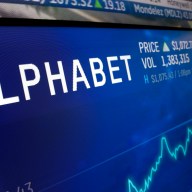 Visit Laarhoven at Back Forty (190 Avenue B., #1, 212-388-1990).
Visit Laarhoven at Back Forty (190 Avenue B., #1, 212-388-1990).
Credit: Maja Lundager Pedersen
When Michael Laarhoven dug in to a steak back in 2007 — an experience he calls “a blur” — it was the first time he had the meat in nine years. But the former vegan had found an organic, ethical alternative to the meat he was used to seeing in kitchen freezers.Fast-forward to today, where we meet him while he’s chopping rib eyes with the precision of a longtime butcher.At Back Forty, he often makes use of the whole animal on his menu — so if you buy a steak, know that somewhere back in the kitchen, Laarhoven’s prepping the tongue or heart to serve that night as well.
Why did you originally become vegan?
When I became vegan in the ’90s it was a reaction to factory farming and genetically modified food. Basically, the food is poisonous to the environment, to us personally and it’s just a disgustingly practice I wanted no part of. So becoming vegan was a political statement against that sort of food. I don’t feel necessarily compassionate towards the animals; it was more a political issue for me. I don’t agree in what you people are trying to give me and tell me is food. That’s why I became vegan, that’s why I stayed vegan and that’s why when I discovered that you can have meat that is responsibly raised and ethically raised, that’s when I got back into eating meat. It was honest food. It wasn’t filled with chemicals and made in some huge factory in the midwest somewhere.
If you should describe Back Forty’s food in three words, which would it be?
We are making honest food. We are answering to the animal. I don’t know if that’s three words. … We have to serve every single part of [the animal]. We don’t just serve steak every day and that’s it. We are going to sell the steak but we are also going to sell the tongue, the heart, the tail, everything you can think of.
So how do you sell the less-than-appetizing parts of the cow?
I think it’s more interesting for someone who comes in here. Rather than just getting a steak they can have a tasting of four or five different parts of the cow that they don’t necessarily know they can eat and know we could make in to a viable dish.
Is it a goal for you as a chef to push guests’ limits?
A little bit, yeah. It’s very important for people to understand that you can eat every part of [the animal]. We don’t want to just be throwing away what you don’t want. It’s wasteful. For the animal that died for you, for the farmer that raised it, for the cook that needs to know how to make food honestly and properly, it’s a waste for everybody. I want to sell the tongue. I don’t want it to go in the garbage.
Where do you pick up inspiration for the dishes?
I don’t know exactly where it comes from. I spend a lot of time reading books about food culture and I’m constantly thinking about food and different stuff that I can do and try, and that shows itself in the food. All summer I was obsessed with barbecue so I bought a bunch of books about that and taught myself everything that I could and by the time September came I had six different barbecue sauces on the menu. And my cooks and my sous chefs and pastry chefs, we just constantly bounce off ideas at each other.
What kind of experience are you trying to give guests?
I’m not reinventing the wheel. I’m not making extremely complicated emulsions. I’m trying to serve them honest food. Just something very simple like our tomato dish right now. Literally it’s just tomatoes with a little bit of salt and then we made a sauce for it. Just something really simple and basic so you can taste the tomato and say ‘that’s a beautiful f-ing tomato’.
















